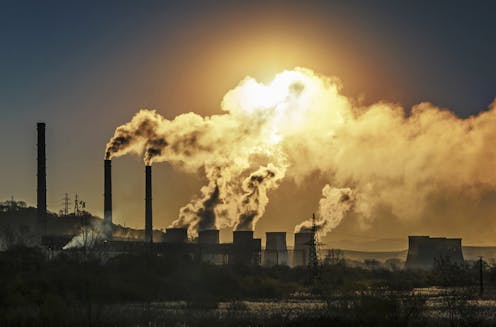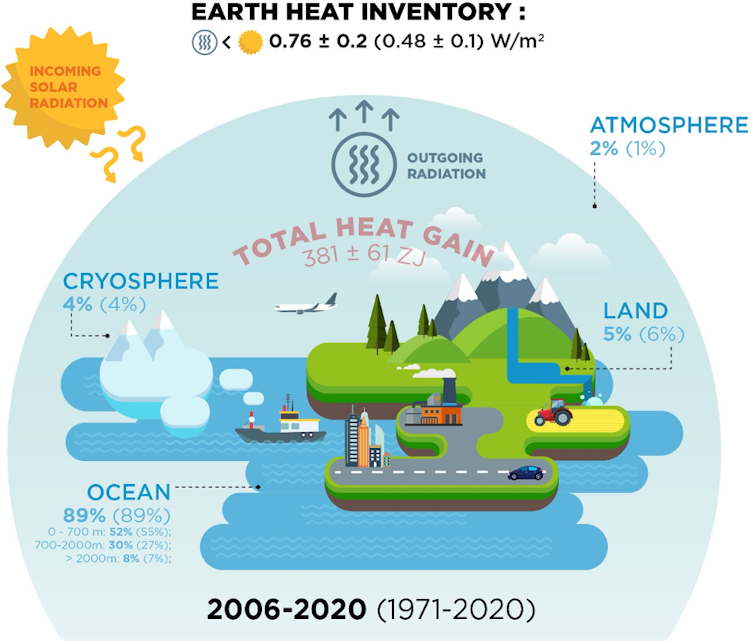
A recent report from the World Meteorological Organization about the state of the climate indicates that the global mean temperature in 2022 was 1.15°C above the 1850-1900 (preindustrial reference period) average. Moreover, the last eight years have been the warmest since the beginning of instrumental temperature records 173 years ago.
In other words, the climate system has been out of balance for several decades.
As an expert in atmospheric science, I aim to shed light on Earth’s energy imbalance and its consequences for humankind.
Earth’s energy imbalance
Solar radiation is virtually Earth’s only energy source, the other energy sources – such as Earth’s interior heat and tidal energy – being negligible. The Earth reflects around 30 per cent of the solar radiation and emits radiation towards space.
The greenhouse gases (carbon dioxide, methane) let solar radiation pass, but not the radiation emitted by the Earth, thus trapping this energy. Earth’s near-surface temperature, which is 15°C, would be around -19°C without the greenhouse effect.
If the difference between the incoming energy – solar radiation – and outgoing energy – the sum of the solar radiation reflected by the Earth and the radiation emitted by the Earth – is not equal to zero, as is the case currently, we refer to this as Earth Energy Imbalance (EEI).
It is human activity, through the emission of greenhouse gases (generating an additional greenhouse effect), that has caused the Earth energy imbalance.
But where does the excess energy accumulate? It accumulates under the form of heat in the different components of the climate system (atmosphere, land, hydrosphere, cryosphere, biosphere). And this is what explains why the Earth is warming, or more globally, climate change.
The ocean, heat accumulator
Assessing the Earth heat inventory through an international effort is essential to better understand the impact of Earth’s energy imbalance on the climate system.
Such an inventory corresponding to the period 1960-2020 has been provided by a recently published study. This study shows that the Earth system has been accumulating heat since 1971. Moreover, the rate of heat accumulation corresponding to the period 2006-2020 is higher than that corresponding to 1971-2020. Most of the excess heat is stored in the ocean (89 per cent), mainly in the upper ocean (0-700 metres in depth). The rest of the excess heat is stored in the land (six per cent) and the atmosphere (one per cent), and has led to the melting of the components of the cryosphere – glaciers, ice sheets and sea ice (four per cent).

In addition to storing excess heat, the ocean is also an important CO₂ sink, thus playing an essential role in the regulation of the climate. However, the ocean will become less efficient at capturing CO₂ with the increase in the cumulative emissions of this gas. Why? Because of the positive feedback between the ocean warming and the decrease in the capacity of the oceans to absorb CO₂.
Unfortunately, the current state of the ocean is concerning. In 2022, the ocean heat content reached a record high, and 58 per cent of the ocean surface experienced at least one marine heatwave. Since mid-March this year, the mean ocean surface temperature is the highest ever observed since the beginning of the satellite era. Among other negative impacts on the marine ecosystems, marine heatwaves cause coral bleaching events.
The consequences of the imbalance
Global warming has negative impacts on humanity and ecosystems, as the recently published Synthesis Report of the Intergovernmental Panel on Climate Change (IPCC) reminds us. This report warns that, currently, between 3.3 and 3.6 billion people live in contexts that are very vulnerable to global warming.
The people who live in coastal areas are particularly affected. The risk of coastal floods increases with sea level rise, which is mainly due to the thermal expansion of the ocean and the melting of the land ice of glaciers and of the Antarctic and Greenland ice sheets. To provide some numbers, the contributions of the ocean thermal expansion and of the land ice melting to sea level rise were, respectively, 55 per cent and 36 per cent for the period 2005-2019.
Global warming is not just a threat to our physical health, but also to our mental health. In effect, sudden-onset events (e.g., hurricanes, storms) can cause trauma. Changes in the climate variables (e.g., drought) can generate a sense of uncertainty. And the awareness of climate change can cause climate anxiety.
This goes to show that the imbalance of the climate system can lead to our own imbalance.
Given the numerous warnings from the scientific community about the harmful consequences of climate change for our societies, we may wonder: Could global warming lead to the collapse of society at a global scale, or even to the extinction of the human being?
Unfortunately, this subject has not received all the attention it deserves. Luke Kemp, researcher at the Centre for the Study of Existential Risk at the University of Cambridge, and his colleagues, have suggested a research agenda with the evocative name “Climate Endgame.”
Win-win solution: Net zero emission
Let’s go back to the origin of the problem: The Earth will continue to warm as long as this energy imbalance persists. Since human-caused emissions are responsible for Earth’s energy imbalance, the solution is, in principle, simple: emissions must be reduced to zero.
What can we do at an individual level? We can reduce our contribution to climate change by using active transportation (walking, biking), by consuming less meat and dairy products, by reducing food waste, and by improving the energy efficiency of our homes, among other actions.
Hence, the climate game is not over. It is up to us to decide whether we want to solve the climate crisis.
But the window of opportunity is quickly closing…
Marta Moreno Ibáñez has received an excellence scholarship from the Trottier Family Foundation.
This article was originally published on The Conversation. Read the original article.







